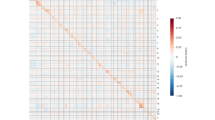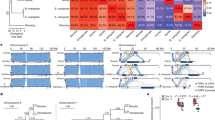Abstract
SPONTANEOUS endo-reduplication in the female germ line of hybrids has made it possible to produce several strains of isogenic Xenopus, providing one of the many features required of a laboratory animal1,2. The usefulness of Xenopus in the laboratory, however, would be improved if a gene map were available. We report here that hybrids can also be used to define linkage groups and their assignment to chromosomes. Our method is based on the possibility of creating aneuploid Xenopus which are diploid for the chromosomes of one species but have supernumerary chromosomes of a second species3. This method complements those already available4–8, and has the advantage that because traits can be monitored in the whole animal, a large repertory of markers will be made available.
This is a preview of subscription content, access via your institution
Access options
Subscribe to this journal
Receive 51 print issues and online access
$199.00 per year
only $3.90 per issue
Buy this article
- Purchase on Springer Link
- Instant access to full article PDF
Prices may be subject to local taxes which are calculated during checkout
Similar content being viewed by others
References
Kobel, H. R. & Du Pasquier, L. Immunogenetics 2, 87 (1975).
Kobel, H. R. & Du Pasquier, L. in Developmental Immunobiology (eds Solomon & Horton) 299 (North-Holland, Amsterdam, 1977).
Kobel, H. R. Arch. Genetik 51 (1978).
Pardue, M. L. Cold Spring Harb. Symp. quant. Biol. 38, 475 (1973).
Pardue, M. L., Brown, D. D. & Birnstiel, M. L. Chromosoma 42, 191 (1973).
Tymowska, J. & Kobel, H. R. Cytogenet. Cell Genet. 11, 270 (1972).
Funaki, K., Matsui, S. & Sasaki, M. Chromosoma 49, 357 (1975).
Schmid, M., Hofgärtner, F. J., Zenzes, M. T. & Engel, W. Hum. Genet. 38, 279 (1977).
Müller, W. P. Chromosoma 59, 273 (1977).
Chang, C. Y. & Witschi, E. Proc. Soc. exp. Biol. Med. 93, 140 (1956).
Du Pasquier, L. & Kobel, H. R. Immunogenetics (in the press).
Du Pasquier, L. & Horton, J. D. Immunogenetics 3, 105 (1976).
Tymowska, J. thesis, University of Geneva (1977).
Thiébaud, Ch. H. & Fischberg, M. Chromosoma 59, 253 (1977).
Author information
Authors and Affiliations
Rights and permissions
About this article
Cite this article
KOBEL, H., DU PASQUIER, L. Hyperdiploid species hybrids for gene mapping in Xenopus. Nature 279, 157–158 (1979). https://doi.org/10.1038/279157a0
Received:
Accepted:
Published:
Issue Date:
DOI: https://doi.org/10.1038/279157a0
This article is cited by
-
Clonal reproduction assured by sister chromosome pairing in dojo loach, a teleost fish
Chromosome Research (2018)
-
Chromosomal transplantation
Chromosoma (1984)
-
Identification of class I major histocompatibility complex encoded molecules in the amphibian Xenopus
Immunogenetics (1984)
-
Histocompatibility antigens and immunoglobulin genes in the clawed toad: Espression and linkage studies in recombinant and hyperdiploidxenopus hybrids
Immunogenetics (1979)
Comments
By submitting a comment you agree to abide by our Terms and Community Guidelines. If you find something abusive or that does not comply with our terms or guidelines please flag it as inappropriate.



